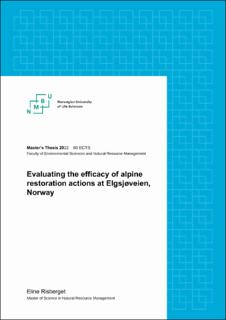| dc.description.abstract | Human induced land-use change degrades natural ecosystems and results in habitat loss, fragmentation, and patch isolation with important consequences for biodiversity and ecosystem functions. Human pressure on natural ecosystems is expected to increase because of the construction of roads and energy production facilities (e.g. hydropower). This makes ecological restoration an important management tool to conserve biodiversity, ecosystems, landscape qualities, and combat climate change. Adoption of international principles and standards for planning and assessing the success of restoration projects can improve outcomes and contribute to the transfer of knowledge from one project to another. However, the application of principles and standards to restoration actions is rare and most restoration projects lack formal evaluation. Thus, the objective of this thesis is to evaluate the efficacy of restoration actions on an alpine plant community.
I monitored vegetation recovery along an access road (Elgsjøveien) that was built for upgrading a hydropower dam within the Knutshø landscape protected area. Based on monitoring from 2016, 2018 and 2021, I used a statistical hypothesis test to compare cover of vegetation and abiotic variables in the restored plots (referred to as disturbed plots in this thesis) against intact plots, and multivariate ordination to compare community composition in disturbed plots against intact plots within habitat types.
One vegetation type, wetland, had similar cover of functional types and abiotic variables within disturbed and intact plots. The other two vegetation types, ridge and willow, had high cover of graminoids and low cover of shrubs in disturbed plots versus intact plots. Additionally, the ridge habitat had low cover of lichens and higher cover of bryophytes in disturbed plots versus intact plots. These findings correspond with the results of total community composition. Total community composition in disturbed zones was similar to nearby intact zones within the wetland habitat, while the disturbed zones in ridge and willow habitats had a community composition that was significantly different than nearby intact communities. This suggests that disturbed wetland habitat is on a trajectory of recovery, but that recovery of other plant community types in the study area may require long periods of time or, in some cases, may not be possible because of the emergence of alternative stable states. This study underscores the importance of applying principles and standards, including assessment, that provides information about ecosystem recovery and the need for dynamic management post-restoration. | en_US |

